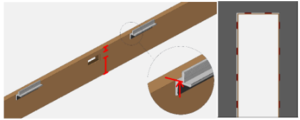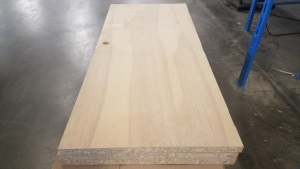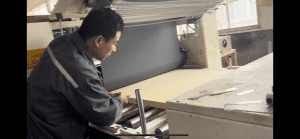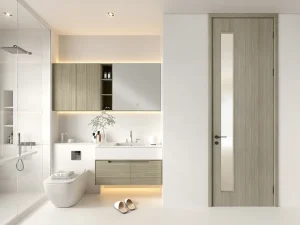Medium Density Fiberboard (MDF) doors have become a popular choice for both residential and commercial interiors due to their durability, affordability, and versatility. Whether you’re a homeowner looking to upgrade your interior doors or a contractor seeking reliable materials for a project, understanding MDF doors is essential. In this comprehensive guide, we will explore what MDF doors are, how they are made, their advantages and disadvantages, and how they compare to solid core interior doors.

What Are MDF Doors?
MDF stands for Medium Density Fiberboard, an engineered wood product made by compressing hardwood or softwood fibers with resin and wax under high temperatures and pressures. This process creates a material that is denser than both plywood and particleboard, making it an ideal choice for door construction. MDF doors are widely used in interior settings due to their smooth surface, stability, and resistance to common issues like warping and cracking.
Unlike solid wood doors, which are crafted from a single piece of timber, MDF doors are made from recycled wood fibers, offering a more sustainable and cost-effective alternative without compromising quality.

How Are MDF Doors Made?
The manufacturing process of MDF doors is key to understanding their strength, durability, and unique properties. Here’s a step-by-step breakdown of how MDF is produced:
- Preparation of Wood Chips: Wood chips are sourced from sawmills or prepared on-site by debarking and chipping logs. These chips may be washed to remove debris.
- Refinement: The chips are steamed in a pressurized digester to soften them, then pulped into fine wood fibers using a refiner.
- Drying: The fibers are dried in tube dryers to reduce moisture content, ensuring stability in the final product.
- Blending: Resins (such as urea-formaldehyde) and additives like wax are mixed with the fibers to enhance bonding and durability.
- Mat Forming: The resinated fibers are air-conveyed onto a moving screen, forming a continuous mat that is pre-pressed and trimmed.
- Hot Pressing: The mat is pressed under high heat and pressure to activate the resin, bonding the fibers into a solid panel. This can be done in a continuous press or a batch-type multi-opening press.
- Finishing: The panels are cooled, sanded, trimmed, and sometimes painted or laminated before being cut into door sizes.
This meticulous process results in a door that is uniform in density and free from the natural imperfections often found in solid wood.

Benefits of MDF Doors
MDF doors offer a range of advantages over traditional solid wood doors, making them a preferred option for many applications:
- No Warping: Thanks to their uniform structure, MDF doors resist warping, cracking, and splitting, even in environments with fluctuating humidity and temperature.
- Smooth Finish: The fine particles in MDF provide a smooth surface, ideal for painting and achieving a flawless finish.
- Customizability: MDF can be easily cut, drilled, and shaped without damage, offering flexibility in design and larger door sizes.
- Water Resistance: Specially treated MDF doors are available for high-moisture areas like bathrooms, providing enhanced protection against water damage.
- Affordability: MDF doors are typically less expensive than solid wood doors, especially when compared to premium species like oak or mahogany.
- Availability: MDF is readily available in various sizes and styles, making it convenient for diverse projects.
- Fire Retardancy: Some MDF doors are designed to be fire-retardant, adding safety in both residential and commercial settings.
- Ease of Use: Contractors can work with MDF using standard woodworking tools, and it can be fastened with screws, nails, or glue.
- Eco-Friendliness: Made from recycled wood fibers, MDF doors are a sustainable choice that reduces waste and maximizes resource use.

Potential Drawbacks of MDF Doors
While MDF doors have many benefits, there are some limitations to consider:
- Scratch Sensitivity: Scratches on MDF cannot be easily repaired, as sanding may compromise the board’s integrity.
- Weight: MDF is denser and heavier than plywood, which can make handling and installation more challenging.
- Sharp Edges: The edges of MDF panels are sharp and require careful handling to avoid injury.
- Health Concerns: Cutting MDF releases fine dust that can irritate the eyes and lungs, necessitating proper safety precautions like masks and ventilation.
- Fastening Challenges: MDF may require more nails or special techniques to avoid splitting, and screw heads can cause surface puckering.
- Moisture Sensitivity: Unsealed edges can absorb moisture and swell, so proper sealing is essential in humid environments.
- Tool Wear: The high glue content in MDF can dull saw blades faster than natural wood.
Many of these drawbacks can be mitigated with proper handling, sealing, and installation techniques.

MDF Doors vs. Solid Core Interior Doors
When deciding between MDF doors and solid core interior doors, understanding their differences is crucial:
- Solid Core Doors: These doors typically feature a wood fiber core with a veneer or composite skin. They are heavier, offer better sound insulation, and feel similar to solid wood doors. However, they can be more expensive and may still warp in extreme conditions.
- MDF Doors: Made entirely from MDF, these doors are lighter, more affordable, and highly resistant to warping. They provide a smoother finish for painting and are easier to customize, though they may not match the soundproofing of solid core doors.
For those seeking affordability, durability, and aesthetics, MDF doors are often the better choice. Solid core doors may be preferred where sound insulation is a priority, such as in bedrooms or offices.

Conclusion
MDF doors are a versatile, cost-effective, and environmentally friendly option for interior door construction. Their resistance to warping, smooth finish, and customizability make them a standout choice for both residential and commercial projects. While they have some limitations, such as sensitivity to scratches and moisture, these can be managed with proper care and installation.
If you’re considering MDF doors for your next project, explore the wide range of options available to find the perfect fit for your needs. For more information on door materials and styles, visit https://www.wpcdoorchina.com/ to discover a variety of high-quality door solutions.




